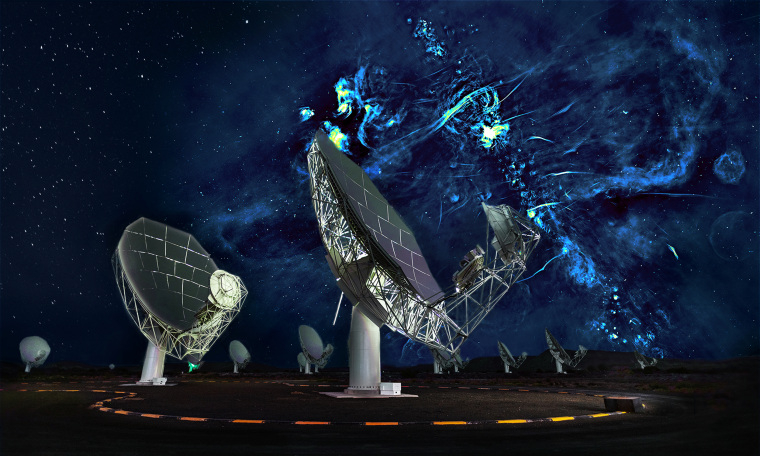A pair of enormous "bubbles" have been discovered at the center of the Milky Way. The mysterious structures, joined together in an hourglass-like shape and spewing radio waves, are thought to be the remnants of a vast cosmic explosion that occurred in our galaxy some 7 million years ago.
The radio-emitting bubbles, described in a paper published Sept. 11 in the journal Nature, measure about 1,200 light-years across and are in an active region near the supermassive black hole at the heart of the Milky Way. Farhad Yusef-Zadeh, a physicist at Northwestern University in Evanston, Illinois, and a member of the international team of scientists behind the discovery, likened this region to a bustling metropolis. By comparison, he said, our solar system lies in a “more rural area” with less activity, about 25,000 light-years from the galactic center on one of the Milky Way’s spiral arms.
"It's good that we don't live at the nucleus of our galaxy," Yusef-Zadeh said. "It's an exciting place to study, but it's a hostile place."
In the 1980s, Yusef-Zadeh had a hand in the discovery of energetic filaments shooting out from near the supermassive black hole, Sagittarius A*. More of these filaments have been observed in the ensuing decades, yet their origin has remained a mystery.
But new observations by Yusef-Zadeh and his collaborators showed that the filaments lie within the newfound bubbles. The finding suggests that “the type of activity that produced the bubbles is also responsible for energizing those filaments,” he said.
Still, the researchers are unsure what caused the filaments and the bubbles to form in the first place. One possibility is that Sagittarius A* spit them out millions of years ago after it went on a sort of feeding frenzy, expelling some of the gobbled-up mass in a violent eruption. Another is that a cluster of stars formed at around the same time, generating an intense amount of energy that was blasted out to create the bubbles.
“Which one is it?” asked Karl Gebhardt, a University of Texas astrophysicist who wasn’t involved in the new research. “That’s where the interesting physics is. These are two very interesting and competing ideas. One has to do with how you feed a black hole, and one has to do with how you make stars in a galaxy.”
Gebhardt added that the new discovery suggests that the Milky Way — though relatively calm compared to other galaxies — was very turbulent in the past. “It tells us that our galaxy is significantly more active than we thought,” he said. “What would be awesome is if we could trace back to when this happened, because once you do that, then you begin to get a picture of how the center of the galaxy evolved.”
The bubbles were observed with the South African Radio Astronomy Observatory’s MeerKAT telescope, an array of 64 dish receivers in Northern Cape, South Africa. The telescope, which began operations in July 2018, is the largest science project in Africa.
Though they are expanding, the bubbles won’t grow forever. Eventually, perhaps in hundreds of thousands or millions of years when they run out of gas in the region, they will simply dissipate, according to Yusef-Zadeh.
The researchers plan to keep monitoring the bubbles, and hope to measure how fast they're expanding. Yusef-Zadeh added that further observations may help the researchers understand whether the eruptions that created the bubbles are one-time events or happen periodically as galaxies evolve.
Want more stories about space?
- China's lunar rover has found something weird on the moon's far side
- Weird 'whiplash' planet is unlike anything astronomers have ever seen
- A trip to Mars could cause brain damage. Here's how NASA aims to protect astronauts.
Sign up for the MACH newsletter and follow NBC News MACH on Twitter and Facebook and Instagram.


